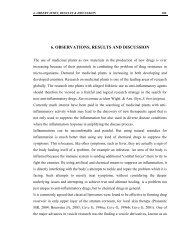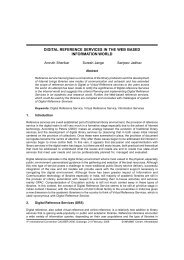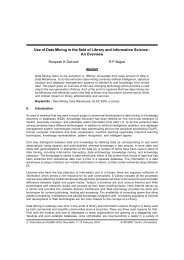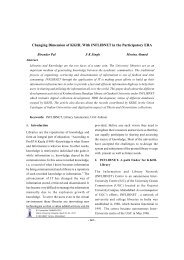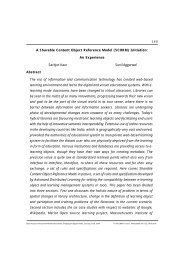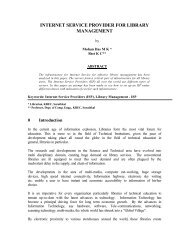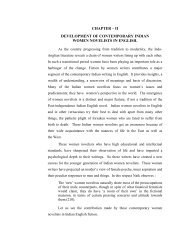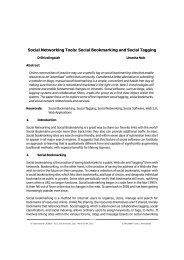Planning for Library Automation: Academic Libraries - DSpace ...
Planning for Library Automation: Academic Libraries - DSpace ...
Planning for Library Automation: Academic Libraries - DSpace ...
- No tags were found...
Create successful ePaper yourself
Turn your PDF publications into a flip-book with our unique Google optimized e-Paper software.
<strong>Planning</strong> <strong>for</strong> <strong>Library</strong> <strong>Automation</strong>: <strong>Academic</strong> <strong>Libraries</strong> 15------------------------------------------------------------------------------------------------------------------------------------------Essentially, what this means is that libraries must plan to use a local library system as a vehicle <strong>for</strong>achieving access to resources outside that system. Stimulated by the Internet, which has created universalconnectivity to in<strong>for</strong>mation resources hereto<strong>for</strong>e unknown and/or inaccessible, and by Z39.50interoperability standards and "gateways," users of individual local systems are expecting to access theresources of other systems-- anywhere and anytime. Moreover, the traditional definition of "publishing"has been stretched by the creation and instant availability of in<strong>for</strong>mational home pages and Web sitesworldwide.Given such increased complexities and heightened levels of expectation, libraries must learn all the morehow to plan <strong>for</strong> the introduction of automation in an organized and systematic fashion. There is littlemystery involved here: It is entirely a matter of building upon what you already know about your library,using tools that are readily at hand and, most importantly of all, involving the people -- staff and users --who must live with the consequences of any automation decisions.WHAT IS LIBRARY AUTOMATIONTraditional library work consisting of acquisitions, technical processing, serials control, circulation andreference services all entail time consuming manual work. Though these activities are essential to properfunctioning of a library, they consume professional staff time that might otherwise go towards userservices and library development. <strong>Library</strong> computerization is now gaining importance necessitating theestablishment of profession-wide standards. Comprehensive studies of library computer systems worldover include discussions of machine-managed acquisitions, cataloguing, serials control, circulation andbibliographic service modules. The literature in this area highlights major aspects of computer’s role inthe library environment. Similar to several aspects of library management, the demand <strong>for</strong> more and fasterin<strong>for</strong>mation services and the decline in library resources are compelling librarians to appreciate the role ofcomputers within their operations. In general, librarians are looking to maximize the benefits ofautomation by spreading computer use to as many aspects of library activities as possible by takingadvantage of developments in computer hardware and software and telecommunications.NEED FOR LIBRARY AUTOMATIONEven though this question seems to be very fundamental it is essential to emphasize this aspect, as thelibrary automation is yet to take off in majority of the Indian libraries. Secondly, while justifying need <strong>for</strong>library automation more than cost-effectiveness the benefits derived by the library users become themajor consideration. To appreciate the advantages it becomes necessary to highlight the different levels oflibrary automation.Following are considered as important factors <strong>for</strong> <strong>Library</strong> <strong>Automation</strong>Ø In<strong>for</strong>mation explosionØ Increase in the collection of librariesØ Inability of users to explore the unlimited literature and in<strong>for</strong>mation of their interestØ Advances in the computer and communication technologyØ Wastage of user / staff time in locating the in<strong>for</strong>mationØ Provide wide access to resources within the libraries and elsewhere-----------------------------------------------------------------------------------------------------------------------------------------------------INFLIBNET Regional Training Programme in <strong>Library</strong> <strong>Automation</strong> (IRTPLA) 2004© INFLIBNET Centre, University Grants Commission, Ahmedabad-380009, India
<strong>Planning</strong> <strong>for</strong> <strong>Library</strong> <strong>Automation</strong>: <strong>Academic</strong> <strong>Libraries</strong> 16------------------------------------------------------------------------------------------------------------------------------------------Ø Better accessØ Quality in serviceØ Cooperative ef<strong>for</strong>ts (Resource Sharing)Out of all libraries an academic library has a difficult task of defining its mission and operatingobjectives. The automation programme will have to mange a wide range of literature associated withnumerous departments and educational programmes of the academic institution. Furthermore, in anacademic library the collections will be diverse unlike a special research library where the collection isrelatively homogeneous. The user group will also range widely, including faculty, staff, students,scholars, administrators and the general public. The position of an academic library funded largely by thegovernment further complicates the process of identifying and prioritizing objectives. As difficult as thetask might at first appear, it is nevertheless essential to the process of establishing automated systems ofany type. In addition the overall health of ones library operation will benefit from a modicum ofintellectual rigor in this area.AREAS OF LIBRARY AUTOMATIONAs a first step in a planning process, it is desirable to <strong>for</strong>mulate a model <strong>for</strong> computerization listing allitemized and prioritized in<strong>for</strong>mation systems being maintained on a manual basis by the library. For thisexercise it is necessary to break down these procedures into their constituent parts. When furthersubdividing these activities, each item is to be considered of its functional elements. The systems andsubsystems listed below are only indicative and may vary with differing library system environments.These are:Acquisitionsselectionorderingclaiming/cancellationreceiving/invoice processingextended procurementsgift trackingFund ControlMaintains in<strong>for</strong>mation about all library related fundsAbility to group funds (nesting)Track fund allocations and adjustmentsFund encumbranceFund expenditureCash BalanceFree BalanceAutomatic updating of fiscal in<strong>for</strong>mation through recording of specific transactionsTrack year-to-date expendituresCreate Purchase OrdersTechnical Services-----------------------------------------------------------------------------------------------------------------------------------------------------INFLIBNET Regional Training Programme in <strong>Library</strong> <strong>Automation</strong> (IRTPLA) 2004© INFLIBNET Centre, University Grants Commission, Ahmedabad-380009, India
<strong>Planning</strong> <strong>for</strong> <strong>Library</strong> <strong>Automation</strong>: <strong>Academic</strong> <strong>Libraries</strong> 17------------------------------------------------------------------------------------------------------------------------------------------BooksSerialsSpecial CollectionsCataloguingBooksSerialsSpecial CollectionsCirculationCharge/RenewalDischargeLoan PeriodsProcessing schedulesHoldsMessagesBlocksNoticesTransaction Recording Devices <strong>for</strong> off-line processingMember controlInventory ControlSerials ControlReceipt (check-in)ClaimingBindery controlreplacementsmonographic serialsinvoice processingReference ServicesDesk servicesUser toolsBibliographic utilizationReprographyInter-library communicationsGeneral AdministrationGrants Administratiuon<strong>Library</strong> PublicationsBinderyPeriodical Citation SearchingOPACBibliographic DatabasePLANNING OF LIBRARY AUTOMATION-----------------------------------------------------------------------------------------------------------------------------------------------------INFLIBNET Regional Training Programme in <strong>Library</strong> <strong>Automation</strong> (IRTPLA) 2004© INFLIBNET Centre, University Grants Commission, Ahmedabad-380009, India
<strong>Planning</strong> <strong>for</strong> <strong>Library</strong> <strong>Automation</strong>: <strong>Academic</strong> <strong>Libraries</strong> 18------------------------------------------------------------------------------------------------------------------------------------------<strong>Planning</strong> <strong>for</strong> library automation has been defined as planning <strong>for</strong> "integrated systems" that computerize anarray of traditional library functions using a common database. While this is still generally true, rapidtechnological change is <strong>for</strong>cing a reexamination of what it means to "automate the library." As physical,spatial and temporal barriers to acquiring in<strong>for</strong>mation are crumbling, libraries must plan <strong>for</strong> a broader andmore comprehensive approach to providing automated services.DEVELOPING A LIBRARY "PROFILE":One of the most important planning tools involves collecting basic statistical in<strong>for</strong>mation on the libraryand its operations. You will find that the same basic data will be needed again and again -- whether <strong>for</strong>vendors from whom you are requesting cost estimates, or <strong>for</strong> other libraries with whom you may beseeking to cooperate in implementing automation.The following are examples of commonly needed data:? Number of titles and volumes in the collection, current and projected;? Number of borrowers, current and projected;? Number of materials circulated, current and projected;? Number of new materials acquired, current and projected;? Interlibrary loans, lent to and borrowed from other libraries;? Description of any cooperative arrangements involving the library; and,? <strong>Library</strong> address and hours of operation.In addition, it is important to take stock of any existing automation in the library by compiling thefollowing data:? Percentage of collection that has catalog records in machine-readable <strong>for</strong>m;? Description of collection without machine-readable records, by category (e.g. monographs,audiovisuals);? Description of currently-automated library functions (if any);? Estimates of the location and number of workstations (to show where you intend to haveequipment in any future system); and,? Specifications <strong>for</strong> any existing equipment to be re-used with any future system (if any).At the same time that this data is being assembled, it is important to assess user needs and set servicepriorities. This can be accomplished by undertaking a focused, strategic planning process designed toinvolve the library's "stakeholders."DEVELOPING A STRATEGIC PLANA library planning to automate should undertake a process by which representative staff and users canidentify service needs and objectives. The purpose of such an ef<strong>for</strong>t is to allow participants to articulatetheir interests and concerns, share perspectives and learn about possibilities in a collaborative setting.Group interaction is an important contributing factor in the success of the goal, which is to develop andsustain library automation in the years ahead.Here are the basic steps involved in this process:? Plan on a two-day, intensive planning ef<strong>for</strong>t.-----------------------------------------------------------------------------------------------------------------------------------------------------INFLIBNET Regional Training Programme in <strong>Library</strong> <strong>Automation</strong> (IRTPLA) 2004© INFLIBNET Centre, University Grants Commission, Ahmedabad-380009, India
<strong>Planning</strong> <strong>for</strong> <strong>Library</strong> <strong>Automation</strong>: <strong>Academic</strong> <strong>Libraries</strong> 19------------------------------------------------------------------------------------------------------------------------------------------? Ask participants to identify strengths, weaknesses, opportunities and threats in the library'senvironment (known as "SWOT" factors in strategic planning) that are characteristic of or thatconfront the library.? Group these factors into critical issue areas that are likely to have an impact on the libraries'future in developing and sustaining automation.? Ask participants to identify ideas and perceptions in relation to the question: "How do you see thelibrary providing user-friendly, cost-effective automated services in five years?"? Through a method of your own devising, ask participants to prioritize all of the ideas that comeout of the above two "brainstorming" exercises.? Ask participants to shape these priorities into the draft of a strategic "vision" <strong>for</strong> automationdevelopment consisting of a statement of purpose, goals and objectives <strong>for</strong> the library.SETTING SERVICE PRIORITIESYour strategic vision must now provide the framework or context <strong>for</strong> the next step in the automationprocess, which is to determine which library functions should be automated and in what order of priority.For example, processes that are repetitive, occupy large amounts of staff time, require retrievingin<strong>for</strong>mation from large, unwieldy files, or are high-profile functions of the library (such as the publiccatalog) are prime candidates <strong>for</strong> automation.Determining the functions that you wish to automate and their priorities relative to each other is important<strong>for</strong> all sorts of reasons. If needs and priorities are clear, functions can be automated in phases, allowing<strong>for</strong> more effective use of frequently scarce funding. Moreover, it is a way to develop credibility withfunding agencies and be able to take advantage of "sudden" funding opportunities. Finally, evaluations ofsystems and options will be easier and more productive if you are able to match your highest functionalpriorities against the corresponding modules available in the marketplace.A WORD ABOUT COSTS...Speaking of funding, planners need to be aware that there are certain cost elements involved in theinstallation and operation of any automated system. These may be summarized as follows:? PLANNING AND CONSULTING COSTS include direct, out-of-pocket costs (e.g., hiring aconsultant) and indirect costs (e.g., training staff) associated with getting started.? PURCHASE OF THE SYSTEM includes the cost of acquiring the initial system hardware andsoftware, as well as the cost of preparing a site <strong>for</strong> the computer system.? TELECOMMUNICATIONS costs are those fees paid to telephone companies <strong>for</strong> connectingremote terminals or workstations to a central computer system.? CONVERSION costs are those associated with the creation of machine-readable bibliographicand, <strong>for</strong> circulation systems, patron, records.? ON-GOING OPERATING costs include...? maintenance fees? utility costs? bar code labels? miscellaneous supply costs? telecommunications costs? salaries and benefits (if extra staff are hired)-----------------------------------------------------------------------------------------------------------------------------------------------------INFLIBNET Regional Training Programme in <strong>Library</strong> <strong>Automation</strong> (IRTPLA) 2004© INFLIBNET Centre, University Grants Commission, Ahmedabad-380009, India
<strong>Planning</strong> <strong>for</strong> <strong>Library</strong> <strong>Automation</strong>: <strong>Academic</strong> <strong>Libraries</strong> 20------------------------------------------------------------------------------------------------------------------------------------------? ADDITIONS TO THE EXISTING SYSTEM may be required to maintain per<strong>for</strong>mancespecifications, to accommodate new users, or to allow <strong>for</strong> additional automated functions.SYSTEM SPECIFICATIONSAt some point, you will need to re-<strong>for</strong>mulate your functional priorities into "functional specifications,"which may be defined as what you want an automated system to do <strong>for</strong> you, including things that yourcurrent manual system cannot do. "Technical specifications" must also be established. These includestandards that must be adhered to, system per<strong>for</strong>mance, operation, and maintenance, as well asinfrastructure requirements, such as stable sources of electricity and telecommunications, and sufficientbandwidth.Developing clear and accurate functional and technical specifications that are specific to your library isone of the most important, if not THE most important, activity that you will engage in as you plan <strong>for</strong>your automated system. These specifications will carry you through the entire procurement process, andwill ensure that the system which most closely matches them will be the most useful and the mostresponsive to your needs.DEVELOPING A FORMAL SPECIFICATIONS DOCUMENTIt is very difficult to compare systems sensibly and pragmatically solely by randomly looking at systems,talking to sales representatives, reading literature or comparing broad cost quotations. For this reason,libraries use a <strong>for</strong>mal document -- often known as a "Request <strong>for</strong> Proposal," or RFP -- that organizes andstandardizes the in<strong>for</strong>mation provided to and requested from the various system vendors.Utilizing an RFP to solicit written responses from vendors makes it possible <strong>for</strong> you to systematicallycompare functionality, cost, maintenance, support, and all the other issues that are involved in systemprocurements. The process can save you money and will result in a wiser decision.An RFP document should include these essential elements, among others:? background in<strong>for</strong>mation on the library;? a description of how the proposals should be arranged and submitted;? instructions on receiving vendor business and financial in<strong>for</strong>mation;? criteria the library will use to evaluate vendor proposals;? questions regarding vendor training and documentation;? your functional and technical specifications.Also, vendors should be asked to describe:? how they will create bibliographic, item and borrower databases;? their system maintenance programs and services;? their site preparation requirements;? their delivery and installation methodologies;? their system per<strong>for</strong>mance guarantees; and? their pricing and cost strategies, in detail.-----------------------------------------------------------------------------------------------------------------------------------------------------INFLIBNET Regional Training Programme in <strong>Library</strong> <strong>Automation</strong> (IRTPLA) 2004© INFLIBNET Centre, University Grants Commission, Ahmedabad-380009, India
<strong>Planning</strong> <strong>for</strong> <strong>Library</strong> <strong>Automation</strong>: <strong>Academic</strong> <strong>Libraries</strong> 21------------------------------------------------------------------------------------------------------------------------------------------EVALUATING VENDOR PROPOSALSUpon the receipt of vendor proposals, it will be time to begin the process of system evaluation andselection. This process involves a number of key steps:? If possible, <strong>for</strong>m a project team of persons to assist with the evaluations and the selection whohave some knowledge of automation or who work in the area(s) being automated. Peopleinvolved in the strategic planning process would be a good choice.? Try to weed out proposals that are "fatally flawed," e.g., where the vendor fails to reply to any ofthe functional specifications or the system is missing a module <strong>for</strong> a high-priority function.? Begin in-depth reading of the "surviving" proposals, carefully noting both deviations from therequirements as defined by the RFP and any aspect that is handled unusually well. Make a list ofany parts of the response that are not clear and require further clarification.? Schedule system demonstrations. They are an important component of the evaluation process.Allow the vendors to show off the vendor's system in the most attractive light; however, beprepared with a list of what you want to see along with questions you would like answered. Usethe same list with each vendor. This permits more effective cross-comparisons.? Consider using computerized spreadsheet software in order to compare and evaluate vendor costproposals. Costs may not be what they seem at first glance.? Contact some of each vendor's current clients-- sites of the same library type, and of similar size,where the hardware and software modules that have been proposed to you are currently in use.? Assign point values to the criteria listed in the RFP and assign scores to the different proposals.The system with the highest score becomes the number one finalist, the system with the secondhighest score number two and so on. To maintain a negotiating edge, it is better to cut to twovendors rather than one. If that is impossible, maintain the illusion anyway. Remember: Theselection process is not over until the contract is signed. Until that point, never let any vendorsknow that they have been eliminated, including those with fatal flaws.PUTTING SYSTEMS INTO PLACEAfter the system selection process is complete, there are several important steps which must occur. Youand your vendor will have to negotiate and sign a contract. You will want to test the system and makesure it suits your needs. You will want to make provisions <strong>for</strong> system maintenance. Finally, you will wantto train both your staff and your users as much as possible to prepare them <strong>for</strong> when the system is up andrunning.With regard to training, the following must be considered: In thinking of automation planning, there isoften a tendency to focus on the hardware and software aspects of planning, and to ignore the humanaspects of automation-- training and public relations. Without these, however, even the most carefullydesigned system may not be accepted by library staff or library users.To assure the success of your hard planning work, a training and public relations plan should be part ofany automation project. Fortunately, training can begin long be<strong>for</strong>e the system is installed. By involvingstaff at all levels in the analysis of operations, the identification of needs, the setting of priorities, thedevelopment of specifications, and the evaluation of systems, staff will gain much of the knowledge theyneed as the planning progresses.-----------------------------------------------------------------------------------------------------------------------------------------------------INFLIBNET Regional Training Programme in <strong>Library</strong> <strong>Automation</strong> (IRTPLA) 2004© INFLIBNET Centre, University Grants Commission, Ahmedabad-380009, India
<strong>Planning</strong> <strong>for</strong> <strong>Library</strong> <strong>Automation</strong>: <strong>Academic</strong> <strong>Libraries</strong> 22------------------------------------------------------------------------------------------------------------------------------------------User acceptance and enthusiasm <strong>for</strong> your new automated system is certainly an important ingredient in asuccessful planning ef<strong>for</strong>t. If you are implementing a public access catalog, it is probably the mostimportant measure of success.Public relations can allow you to accomplish three things:? make users aware of your new system and services;? motivate them to use the system; and,? train them in using the new system and services effectively.RETROSPECTIVE CONVERSIONIn the rush to acquire hardware and software, librarians often <strong>for</strong>get that their most valuable product is thelibrary's database. The creation of a high-quality machine-readable database provides the cornerstoneupon which all present and future automation ef<strong>for</strong>ts rest. Vendors will come and go, hardware willbecome obsolete, software will be replaced, but a well-constructed, well-maintained database, with itsaccompanying local holdings, will be the library's transportable and viable link from system to system.Moreover, as library users begin to access not only their local system but systems in other libraries aswell, the quality of respective databases will influence both the outcome of search strategies and theavailability of materials.Database readiness has several important facets:? Catalog records must be carefully converted from manual to machine-readable <strong>for</strong>mats;? Collections must be prepared <strong>for</strong> conversion through effective and ongoing weeding andinventory programs;? Once converted, collections must be properly maintained as titles are added, withdrawn,transferred and recataloged; and,? Standards -- <strong>for</strong> bibliographic, item and patron records as well -- must be adhered to. Inparticular, adherence to well-established and accepted standards of description <strong>for</strong> bibliographicin<strong>for</strong>mation in a machine-readable database is critical because:? without standards, files cannot easily be transferred from one automated system to another, and,? it is essential <strong>for</strong> libraries wishing to participate in resource sharing arrangements with otherlibraries, who will require such adherence as a condition of participation.CONCLUSIONIn an increasingly complex and global in<strong>for</strong>mation environment, a <strong>Automation</strong> of library is of vitalimportance in enabling end users to search through large quantities of in<strong>for</strong>mation. Effective resourcesharing nowadays requires an infrastructure, which permits users to locate materials of interest in bothprint and electronic <strong>for</strong>mat. Access across multiple collections is becoming increasingly critical. A centralunion catalogue linked to article citation databases, full text resources and local library resources, incombination with a functional user interface and powerful search- and index engine, offer importantbenefits to users. Predictions based on current trends of course ignore one importance factor.Technological advances are often unpredictable, and frequently the most exciting and the most significantare those which can least be <strong>for</strong>eseen. When breakthroughs come, there<strong>for</strong>e it seems reasonable to thinkthat the profession will be ready <strong>for</strong> them, and eager to put them to effective use.-----------------------------------------------------------------------------------------------------------------------------------------------------INFLIBNET Regional Training Programme in <strong>Library</strong> <strong>Automation</strong> (IRTPLA) 2004© INFLIBNET Centre, University Grants Commission, Ahmedabad-380009, India
<strong>Planning</strong> <strong>for</strong> <strong>Library</strong> <strong>Automation</strong>: <strong>Academic</strong> <strong>Libraries</strong> 23------------------------------------------------------------------------------------------------------------------------------------------Computer technology and software applications are changing and evolving at an incredibly rapid pace. Atcurrent rates of development, you can expect that by the time you install your carefully planned system,capabilities will be available that were only in planning while you were evaluating vendor proposals. Ingeneral, a life cycle of five years is considered to be acceptable <strong>for</strong> a computer system be<strong>for</strong>e somesignificant upgrade (installation of additional hardware and/or software providing <strong>for</strong> increased capabilityor capacity) or replacement will be necessary. Because computer and in<strong>for</strong>mation technology represent afundamental change in the way libraries do business, libraries must make an ongoing commitment tokeeping pace with change. There<strong>for</strong>e, like automated systems, plans must also change with time. Plansmust be regularly revisited and updated as the environment and needs change. In general, a library shouldconduct a major reexamination of its plan every five years, and should review its plans on an annual basis.-----------------------------------------------------------------------------------------------------------------------------------------------------INFLIBNET Regional Training Programme in <strong>Library</strong> <strong>Automation</strong> (IRTPLA) 2004© INFLIBNET Centre, University Grants Commission, Ahmedabad-380009, India




